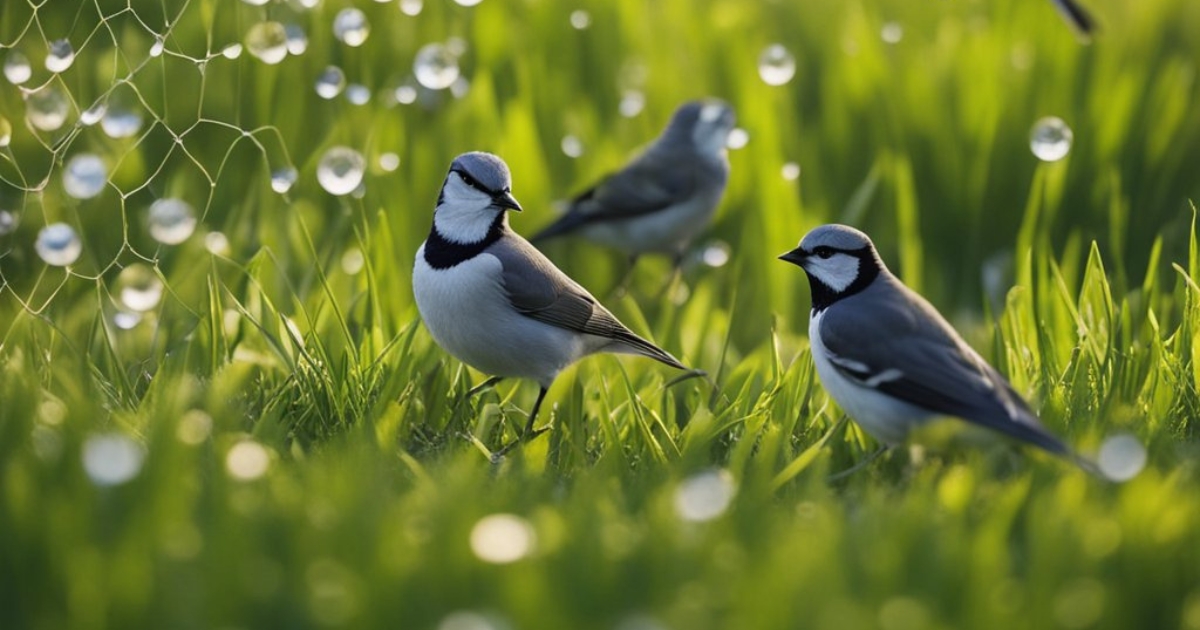If you’ve ever planted grass seed only to have birds swoop in and feast on your hard work and investment, you know how frustrating it can be. Birds love to eat grass seed, which is like candy to them with all the nutrients it contains. While birds performing this act are simply following their natural instincts to forage for food, it leaves you with patchy, sparse grass, or sometimes none at all.
The good news is that there are ways to deter birds and prevent them from treating your newly seeded lawn like an all-you-can-eat seed buffet. With some strategic planning and bird deterrents, you can
Timing is Key
One of the best ways to avoid having birds eat your grass seed is to time your planting strategically. There are certain times of year when birds are less active and focused on grass seed. Taking advantage of these seasons will go a long way toward preventing bird damage.
Plant in Early Spring or Late Fall
The optimal times to plant grass seed are early in the spring, as soon as the ground can be worked, or late fall. During these times, birds are busy with nesting and breeding in the spring. Come fall, they are focused on preparing for winter and are not as intent on foraging.
Cooler weather during spring and fall means birds are expending more energy staying warm. This leaves them less motivated to hunt down grass seed. Planting during the peak heat of summer or the cold of winter is risky because of weather extremes. Focus your efforts in early spring, when the average daytime temperatures reach into the 50s and 60s, or fall when nighttime temperatures are consistently below 55 degrees Fahrenheit.
Avoid Peak Feeding Times
When planting in spring or fall, be sure to avoid peak feeding times for birds. Early morning and late afternoon into evening tend to be the most active times for birds to be searching for food. Try to prepare and seed lawns during mid-day when bird activity drops off slightly. This narrow window when birds are less active can make a big difference.
Create Physical Barriers
In conjunction with proper timing, creating physical barriers over your newly seeded lawn can be highly effective at deterring birds. Temporary covers will protect the vulnerable grass seed until it can germinate and establish a turf cover.
Use Row Covers or Netting
Lightweight row covers or plastic netting can be installed over the entire lawn or just over problem areas prone to heavy bird traffic. The material should allow sunlight and air to penetrate but have holes too small for birds to access. Look for row covers with a 0.5 to 1.0 mm mesh size.
Weigh Covers Down
Any covers or netting will need to be securely weighed down once in place. Use landscape fabric pins, rocks or other heavy objects placed around the edges and throughout the material. Check that covers are taught with no gaps where birds could sneak underneath.
Check Covers Regularly
Be diligent about checking covers daily to ensure they are still secured properly. Repair any holes or gaps immediately to maintain the protective barrier. Remove covers carefully once grass seeds have germinated and established some growth, typically 2-3 weeks after planting.
Learn more about using row covers for seeded lawns
Use Chemical Bird Repellents
Applying chemical bird repellents is another tactic in the battle against birds eating grass seed. Repellents use various active ingredients known to be unpalatable or irritating to birds. These liquid products can be sprayed directly on recently seeded areas.
Look for Common Active Ingredients
Check product labels for common bird repellent ingredients like methyl anthranilate, anthraquinone, and capsaicin. Methyl anthranilate produces a grape flavor birds dislike. Anthraquinone irritates bird digestive systems. Capsaicin is the chemical that makes chili peppers hot and burns birds’ mouths. Look for products containing these proven bird deterrents.
Reapply After Rain or Watering
Understand that liquid bird repellents may need to be reapplied after significant rain or lawn watering. The repellents can wash away requiring renewal of the protection. Be prepared to respray if heavy watering is needed to establish the grass seeds. Granular repellent products tend to hold up better than liquids with fewer reapplications necessary.
Use Scare Tactics
Incorporating fright tactics into your bird deterrence plan is recommended for optimal results. Birds are skittish creatures by nature and can be scared off by introducing alarming objects, sounds, or lights.
Use Decoys, Lights, or Sounds
Place plastic predator decoys such as owls, hawks or snakes around the lawn to frighten seed-eating birds.Set up flashing lights or wind spinners to startle birds when motion activated.Play recordings of bird distress calls or predator sounds like coyotes to scare birds away.Introduce unexpected loud noises by hanging pie pans, clanging metal lids or other noisemaking devices around the yard.
Change Location of Decoys
For maximum effectiveness, remember to move decoys every 2-3 days and vary the placement of lights and sounds. If frightened objects remain stationary, smart birds will quickly catch on that they are not actually threatening. Keep birds guessing by frequently changing things up.
Apply Bird Feed Elsewhere
You can steer birds away from freshly seeded grass by giving them an appealing alternative food source. Set up bird feeders stocked with seed, suet and nectar away from the tempting lawn area.
Divert Birds with Feeders
Most birds will choose to frequent bird feeders laden with their favorite treats over scavenging in the grass. Generously feed the birds in areas away from newly seeded turf to divert their attention. Once they grow accustomed to using the feeders, they’ll focus the majority of their foraging there.
Keep Feeders Full
Be sure to maintain the feeders regularly, keeping them filled with fresh seed and clean nectar. Well-fed birds are less likely to stray from the feeders in search of the nutrition in grass seed. Satisfied birds will become loyal patrons at productive feeders.
Reseed if Needed
Even with multiple bird deterrence strategies in place, you may still experience some grass seed loss. Hungry birds are resourceful when they are determined to eat. Be prepared to reseed areas where grass growth is too sparse or nonexistent.
Expect Some Bird Damage
Mentally prepare yourself that there will likely be at least some bird damage, as completely preventing birds from accessing all seed is difficult. Monitor progress closely as grass sprouts and fill in thin spots as needed.
Wait for Lower Activity to Reseed
If reseeding bare areas is required, play the waiting game until spring or fall, when bird activity decreases. Reseed then when seed-eating birds are occupied with migration or other priorities. Your chances for seed success are much higher.
People also Read:
Conclusion
Birds can quickly destroy newly seeded grass if left unchecked. Their natural feeding behaviors compel them to seek out the nutritious seeds you worked so hard to plant. However, there are many defenses against birds that can save your grass seed investment. The most critical strategy is timing your planting in the spring after nesting or fall before winter when bird activity declines. Adding physical barriers such as row covers or chemical repellents provides further protection. Finally, scare tactics and bird feeders create an inhospitable environment that encourages birds to feed elsewhere. Remaining vigilant by using multiple deterrents will allow your grass seed to germinate successfully into the lush lawn you desire. With some diligence, you can outsmart pesky seed-stealing birds.
FAQs
What is the best time of day to seed a lawn to avoid birds?
The best time is midday when bird feeding activity decreases slightly. Avoid early morning and late afternoon when birds actively forage.
How soon can I remove row covers after seeding the lawn?
Leave row covers in place for 2-3 weeks until new grass shoots have established and taken hold. Removing too soon risks exposure to seed-eating birds.
How often should I reapply liquid bird repellent on grass seed?
Plan to reapply liquid repellent every 5-7 days, especially after significant rain or lawn watering that may wash it away. Granular products are more persistent.
Where is the best place to position scare devices like flashing lights?
Position them prominently high up overlooking the entire lawn for maximum visibility. Move periodically so birds don’t become accustomed.
Should I take down my bird feeders when seeding grass?
No, you can keep feeders up to divert birds away to them. Just position well away from seeded areas so birds aren’t tempted nearby.

